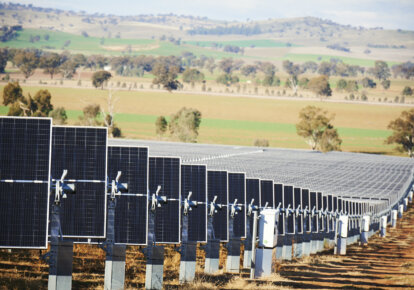Flow Power was delighted to attend the Refrigerated Warehouse and Transport Association conference and host a panel on “The Future of Energy in the Cold Chain”. We had the pleasure of bringing together a sensational line up of panelists to discuss the opportunities available for the cold storage industry in the energy space.
Thank you to our very own General Manager of Energy Solutions Jacob Mahoney, CEO Jarrod Leak from Australian Alliance for Energy Productivity (A2EP) and Managing Director Michael Bellstedt from refrigeration engineering consulting firm Minus40 for participating in the discussion and revealing the following insights for the members of the RWTA.
An update on the market
The past few months have been an unprecedented time for the National Electricity Market (NEM). A perfect storm of factors affecting operation resulted in the Australian Energy Market Operator (AEMO) stepping in and temporarily suspending the market in June.
Prices have been at an all-time high, mainly due to the current war in Ukraine causing global economic supply chain issues and resulting in exceptionally high domestic prices for coal and gas.
Meanwhile in Australia, a third consecutive La Niña event is predicted to hit. As our nation is becoming increasingly reliant on renewable energy sources, particularly solar and wind, long term climate patterns such as La Niña increasing cloud cover and resulting in low solar generation has further contributed to supply issues across the National Electricity Market (NEM).
Thermal generator outages and interconnector constraints continue to reduce availability and result in price volatility throughout the last few months. Furthermore, generators often use this time of year (where heating demand drops, the demand for cooling is low and renewables are ramping up) for planned maintenance, which may also lead to the NEM experiencing a drop in availability and not operating as efficiently over the coming months.
What does this mean for cold storage?
For cold storage facilities, one of the highest operating costs is energy and with energy prices on the rise, it is more important than ever for cold stores to have energy efficiency strategies in place to help reduce or avoid the high price periods.
Due to their refrigeration systems and flat load profile (typically operating with near constant refrigeration 24/7, 365 days a year), cold storage facilities can decrease usage when wholesale prices are higher – usually in the morning between 7-9 AM and in the evening between 5-7 PM.
By reducing electricity usage during these periods when consumer electricity demand is high and low amounts of renewable energy are being supplied to the grid, cold stores are reducing demand strain on the grid and driving energy costs down without effecting day to day site operations or impacting temperatures of stored products. This however, is only possible under an agreement which incentivises customers to optimise their electricity time of use.
Reducing dependency on the grid
Given the current state of the energy market, looking at alternatives to reduce dependence on the grid is another way cold stores can manage their electricity costs.
Solar
Maintaining stable temperatures, especially in frozen food scenarios, requires continuous refrigeration and therefore a considerable amount of energy. This is where onsite energy generation such as solar panels can be very cost effective for cold storage businesses.
Solar panels can be installed on-site, and energy is generated without having to rely on the grid or diesel generators which can be costly to run and maintain. Compared to other sources of power, diesel generators have the most expensive fuel and due to their fuel injection system are more likely to break down, resulting in lack of reliability and high cost for spare parts.
Batteries
Surplus energy from solar panels can be stored in batteries and utilised when demand and prices are high (typically in the morning or afternoon) and there is low renewable generation.
Batteries can help to reduce operational risk as thermal backup allows refrigeration facilities to maintain safe temperatures and preserve food quality during equipment failure or power outages, reducing food loss and business interruption.
Batteries can also export energy back to the grid in in times of high demand with generous compensation for market participants.
Transitioning from fossil fuels
Due to their high consumption and cost, fossil fuels such as diesel, gas and petrol are considerably inefficient when it comes to refrigerated transportation.
Phase change materials (PCMs)
PCMs are substances that change from solid, liquid, or gas to another state to provide useful heating or cooling. The primary objective of applying PCMs to commercial refrigeration is to reduce or shift the cooling load, while maintaining a stable temperature and keeping stored products consistently cold.
From a grid perspective, one of main benefits of PCMs is how well they enable flexible load management through pre-cooling a refrigeration system ahead of a peak price period, event or power outage. Not only can this contribute to big energy savings but also significantly reduces the need for carbon-intensive fuels from non-renewable sources.
Waste heat
As cold stores produce a huge amount of waste heat from the refrigeration process, waste heat recovery is becoming increasingly recognised as a key opportunity for them to improve their bottom line while reducing carbon emissions.
Modern refrigerators, specifically those using ammonia or CO2 refrigerant, offer significant recovery potential at useful temperature levels (greater than 50°C). This recovered heat can offset the energy consumption of other operations, such as heating water or space, resulting in reduced site energy consumption.
Power Purchase Agreements
Installing solar panels on site is not always the most cost-effective solution for all cold storage businesses. This is where an in front of the meter Power Purchase Agreement (PPA) can be beneficial as it allows businesses to pre-purchase up to 100% of their grid energy usage via a renewable energy project, securing long-term pricing with cheaper electricity rates compared to the market.
Behind the meter PPAs
As opposed to an in front of the meter PPA where offtake is purchased from a solar or wind farm, a behind the meter PPA is also possible for cold stores who are looking to reduce their energy costs. An energy provider installs renewable energy on the business’ site, offsetting their entire electricity bill including network charges as there is no dependency on the grid.
Is this energy contract right for your business? Learn more about PPAs here.
Advice from your energy specialists
Energy management should be looked at holistically, implementing a number of solutions to maximise energy savings. Most cold storage facilities can easily take part in wholesale contracting, demand management and energy efficiency measures (behind the meter solutions, smart tools and data monitoring) to help drive down the cost of their energy bill.
At Flow Power, we see many businesses sit idly and typically wait until contracts are about to renew in January for a strategy to help them save in the short term. For the best outcome, we strongly encourage our customers to plan ahead and reach out to us far in advance for the best deal on their energy contract. For more information on our power plans, click here.
Any questions? We’re here to help.
If you’re a Flow Power customer already, please reach out to your dedicated Client Solutions Manager.
If you’re not a Flow Power customer contact our friendly team today:
? 1300 08 06 08 (within business hours)
?️ Live chat message (within business hours via the chat button at the bottom of your screen)
Alternatively, you can submit your questions through our website contact form here.














